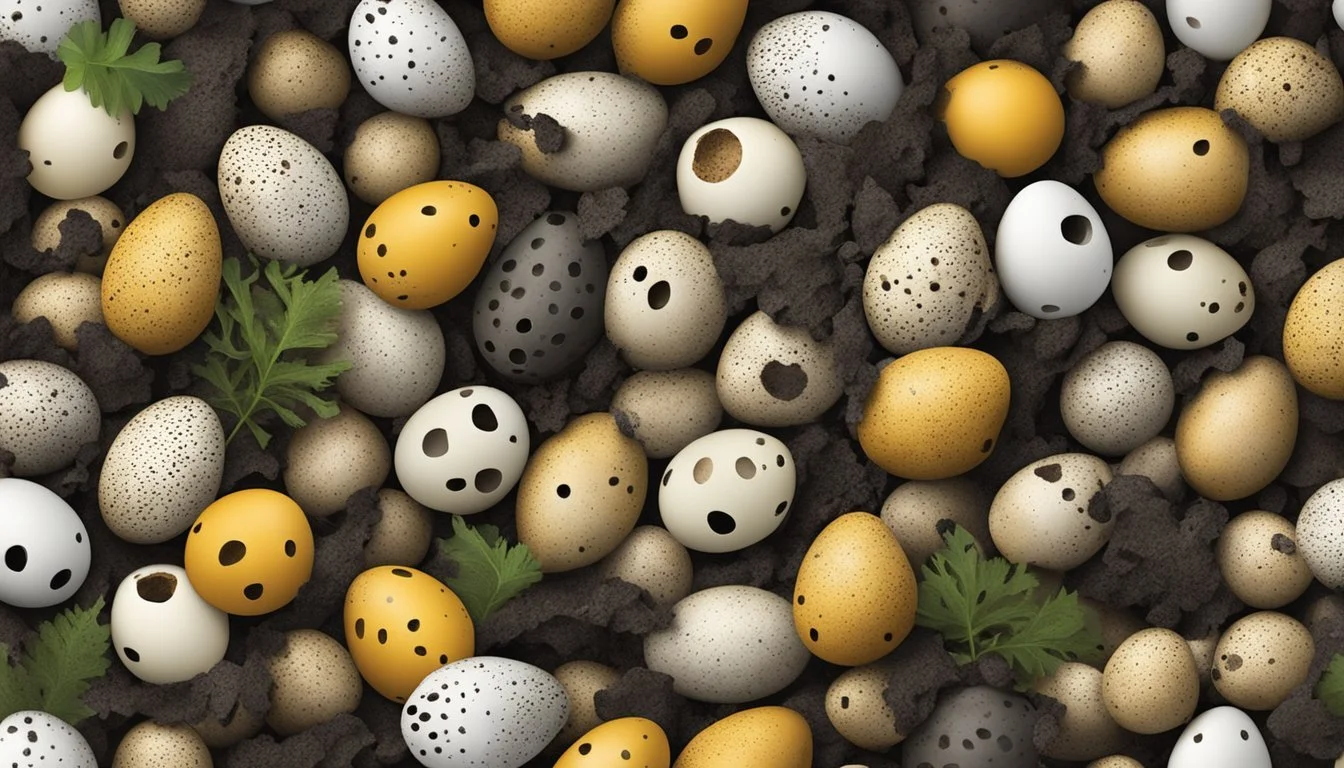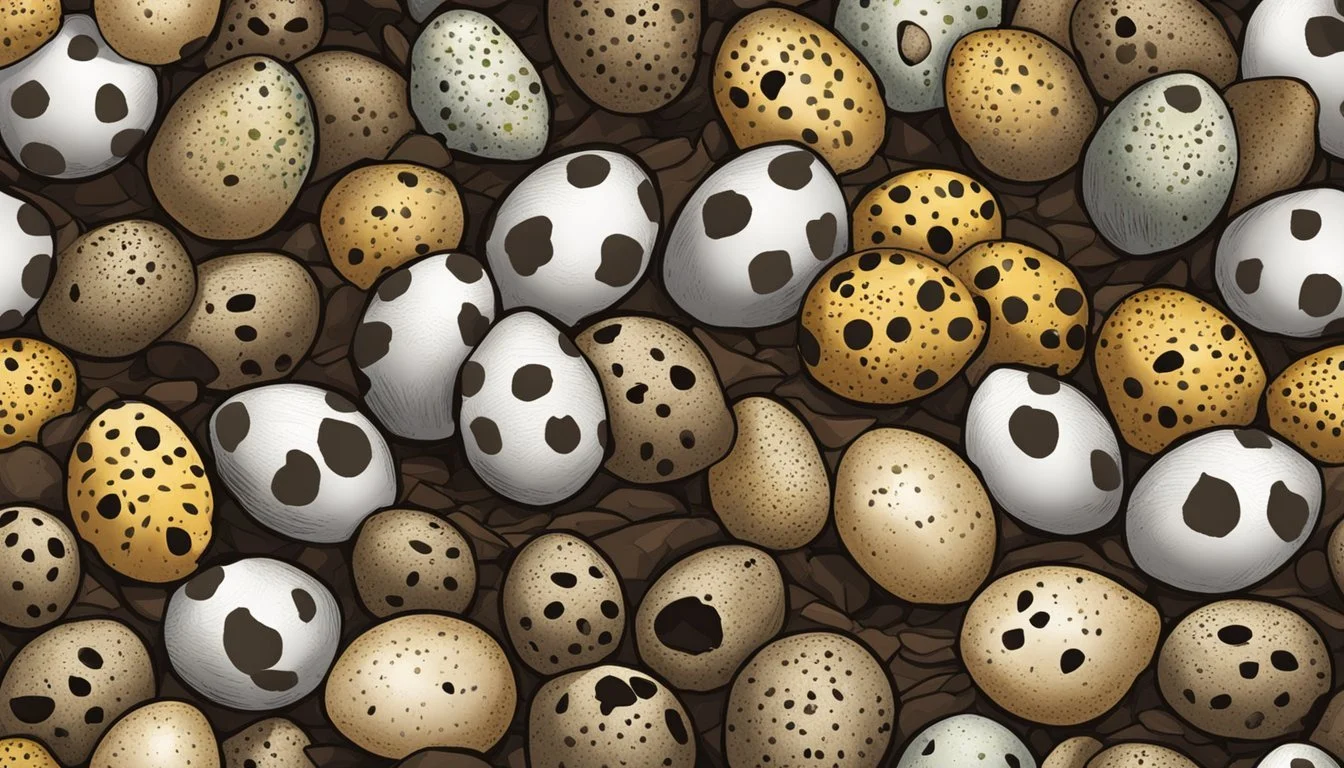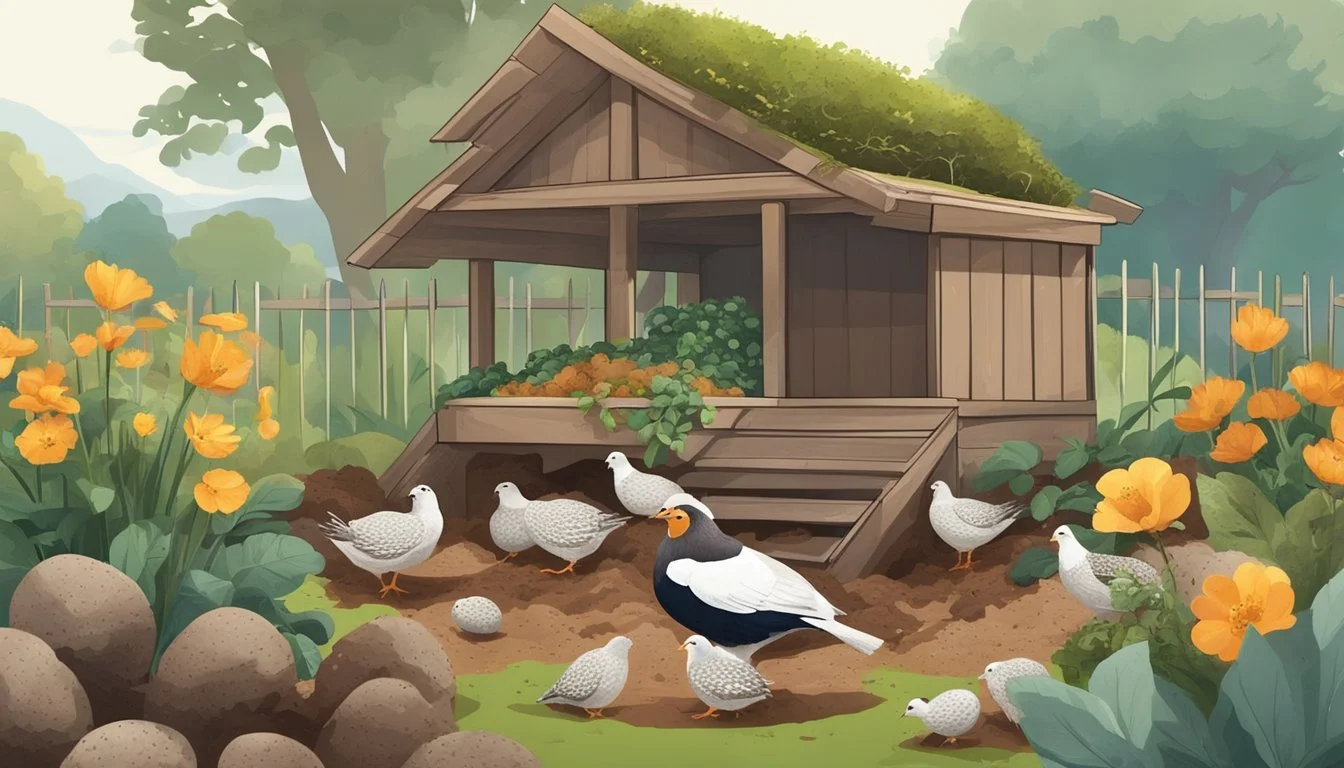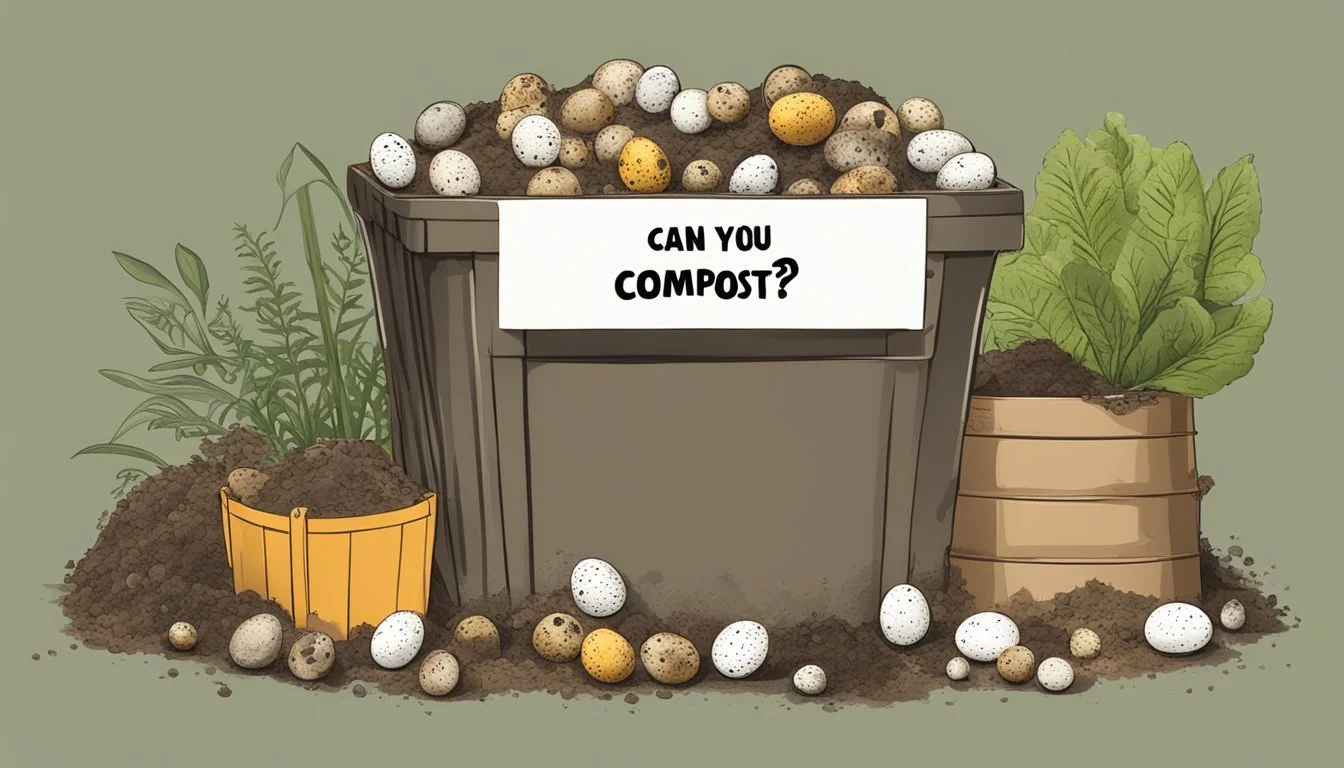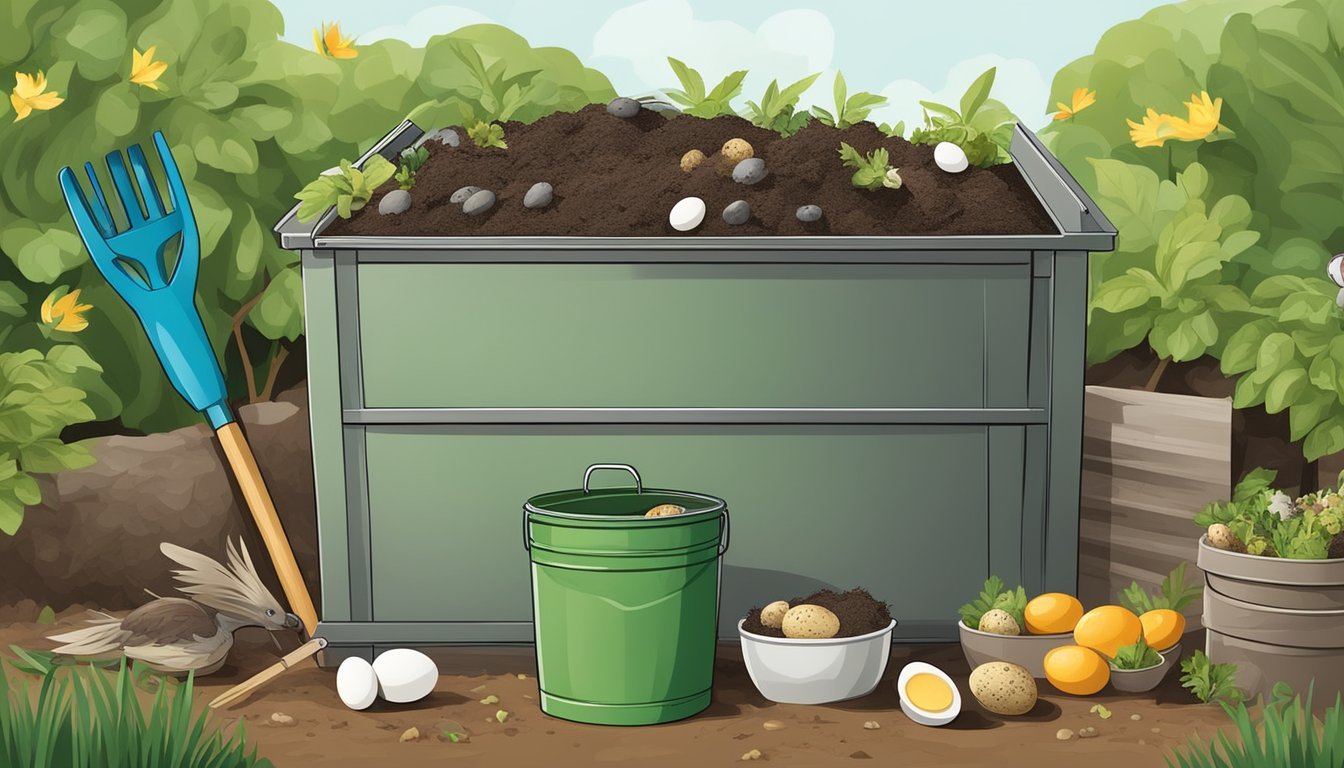Can You Compost Quail Eggs?
Understanding Eggshell Composting Essentials
Composting quail (What wine goes well with quail?) eggs is a practice that can benefit gardeners by recycling nutrients and reducing waste. Similar to chicken eggs, quail eggs and their shells can be added to compost bins or piles. However, it is important to do so correctly to prevent attracting pests and to ensure the composting process works efficiently.
Quail eggs possess nutritional elements that are beneficial to plant growth when composted. The shells, which are rich in calcium, contribute to soil health by improving its structure and providing essential nutrients for plants. When composted, both the eggs and shells decompose, releasing these nutrients back into the soil and reducing the volume of organic waste in landfills.
It is essential to manage the composting of quail eggs carefully to avoid common issues such as odors or the attraction of rodents and other pests. Methods such as burying the eggs deep within the compost pile or using a closed composter can mitigate these problems. By taking appropriate steps, gardeners can safely and effectively incorporate quail eggs into their composting routine.
Understanding Quail Eggs
Quail eggs are small but nutrient-rich, and they are produced by various quail breeds, each offering different levels of egg production.
Quail Egg Basics
Quail eggs are significantly smaller than chicken eggs, typically weighing about 10 grams. Despite their size, they are enveloped in a protective layer known as the bloom which guards against bacterial contamination. This bloom diminishes over time, making proper storage crucial for maintaining their freshness. Quail eggs hatch in approximately 14-18 days, and the quails reach maturity at about 8 weeks, rapidly starting their egg-laying cycle.
Nutritional Content
Quail eggs carry a robust nutritional profile with high protein content and an array of minerals and vitamins essential to a balanced diet. They are a good source of B-vitamins and contain important minerals such as phosphorus, calcium, and iron. These eggs may contribute significantly to dietary intake of these nutrients when consumed as part of a regular diet.
Quail Breeds and Egg Production
The breed of quail is a determining factor in both the quantity and frequency of egg production. Some quail breeds can lay up to 300 eggs per laying season, with egg-laying potentially beginning as early as 6 weeks of age. The environment, quality of quail feed, and the specific nutritional content of their diet can influence egg production rates and the overall health of the quail.
Fundamentals of Composting
Composting is an effective method for converting organic waste into valuable fertilizer, with a particular focus on maintaining the right mix of nitrogen and carbon.
Composting Process
The composting process involves the decomposition of organic material into a nutrient-rich humus. A successful compost pile requires a balance of green, nitrogen-rich materials and brown, carbon-rich materials. Nitrogen acts as a protein source for the microorganisms that facilitate the decay process, while carbon serves as an energy source. For proper composting, one should ensure that these elements are in the right proportions, typically a carbon to nitrogen ratio of about 30:1.
Benefits of Eggshells in Compost
Eggshells provide significant benefits when included in a compost pile. They are an excellent source of calcium and other minerals that contribute to the overall fertility of the compost. When added to the pile:
Eggshells should be rinsed to remove any leftover egg content, which could attract pests.
Crushed eggshells help to aerate the compost, improving its structure.
Including eggshells enhances the nutrition of the compost, which in turn supports healthier plant growth.
Balance of Nitrogen and Carbon
A central tenet in successful composting is maintaining the proper balance of nitrogen and carbon. Organic waste like kitchen scraps is high in nitrogen, which heats up the compost pile and speeds the decomposition. Conversely, carbon comes from brown materials like dry leaves and paper. A compost pile should ideally have:
A balance with more carbon than nitrogen, aiming for a ratio of about 30 parts carbon to 1 part nitrogen.
Proper aeration and moisture to facilitate microbial activity.
The correct carbon-to-nitrogen ratio ensures an efficient breakdown of materials and reduces the likelihood of odors and pests.
Executing Quail Egg Composting
Composting quail eggs can enrich a compost pile with nitrogen, essential for the composting process. Still, specific steps need to be followed to avoid spoilage and odor issues.
Preparation of Quail Eggs for Composting
To start, one must prepare the quail eggs properly. Raw quail eggs should be broken and crushed, including their shells, to expedite decomposition. The eggshells, rich in calcium, can provide beneficial minerals to the compost. It's essential to rinse the shells to eliminate any residue to lower the risk of attracting pests and prevent the spread of bacteria.
Incorporating Quail Eggs into the Compost
Quail eggs, like other organic waste, should be balanced with carbon-rich materials to maintain a healthy compost. One part nitrogen (quail eggs) to 30 parts carbon (e.g., leaves, straw) is recommended. Distribute the egg components evenly throughout the compost pile to prevent clumps that could lead to spoilage.
Monitoring the Compost Condition
Regularly inspect the compost pile for signs of proper decomposition and the absence of foul odors, indicating that the quail eggs are being composted correctly. Turning the compost pile periodically can help to aerate it, which is crucial in controlling odor and facilitating the sustainable break down of all organic waste, including quail eggs and eggshells.
Potential Challenges and Solutions
When composting quail eggs, one may encounter issues related to odors and pests, potential pathogen contamination, and overall compost health. Addressing these challenges is crucial for a successful composting process.
Preventing Odors and Pests
Quail eggs, like other organic material, can emit odors as they decompose, which may attract various pests including rodents and raccoons. To mitigate this:
Balance the compost: Ensure a proper balance between nitrogen-rich materials (like quail eggs) and carbon-rich materials such as leaves, straw, or sawdust.
Bury the eggs: Layer quail eggs in the center of the pile to minimize exposure and discourage pests.
Regularly turn: Aerating the pile prevents an anaerobic environment, which is a key cause of unpleasant smells.
Salmonella and Pathogen Concerns
The primary concern with composting quail eggs is the potential presence of salmonella bacteria and other harmful pathogens. To address these issues:
Heat the compost: Maintain the pile between 135°F and 160°F to kill pathogens.
Treatment: Consider pretreating the eggs with boiling water or lime to disinfect before adding them to the pile.
Maintaining Proper Compost Health
Maintaining a healthy compost pile is essential for the efficient breakdown of materials, including quail eggs. For optimal health:
Compost composition: Monitor the compost's moisture and temperature to ensure that it remains conducive for decomposition.
Turn and mix: Frequent turning mixes the contents and introduces oxygen, which is vital for composting.
Pest control: Implement natural pest control methods or compost bin designs that deter animals.
Beyond Composting: Raising Quail Sustainably
Raising quail sustainably requires attentiveness to their housing, diet, and integration into a homesteading environment. This section outlines the best practices for quail care to ensure a productive and eco-friendly approach.
Quail Housing and Care
Proper quail housing is crucial for protection against predators such as hawks, raccoons, and rats. Sturdy enclosures with secure fencing and covered tops can prevent attacks. Including nesting boxes provides quail with a safe environment for laying eggs. Quail thrive in clean environments, so regular maintenance of their housing to remove wastes is necessary.
Enclosure specifications:
Minimum size: 1 square foot per bird
Protected against predators
Easy to clean and maintain
Feeding and Diet
A balanced diet is essential for quail health and egg production. High-quality quail feed typically consists of game bird feed with around 20% protein. This can be supplemented with vegetables and seeds for additional nutrients. Clean, fresh water should be available at all times.
Dietary essentials:
Protein-rich feed
Fresh greens and grains
Constant water supply
Homesteading with Quail
Integrating quail into a homestead environment can balance the ecosystem and provide a steady supply of eggs. Quail are smaller and quieter than other poultry, making them an excellent choice for small-scale livestock. When selecting quail breeds, consider the specific requirements and benefits, such as the hardiness of certain breeds like the Button quail.
Benefits on a homestead:
Small space requirement
Low noise levels
Nutrient-rich manure for composting
In conclusion, with mindful care, quail can be an eco-friendly and rewarding addition to any sustainable homesteading endeavor.
Utilizing Finished Compost
Finished compost, a humus-like material, is a key ingredient in creating nutrient-rich soil. It can significantly improve soil structure, boost microbial activity, and reduce greenhouse gas emissions by sequestering carbon.
In the Garden
In the garden, finished compost can be applied directly to the soil to enhance its fertility. Here's how gardeners can use it:
Top-dressing: Spread a 2-3 inch layer of compost over the garden bed, which will slowly integrate with the garden soil.
Soil amendment: Before planting, mix compost into the existing soil to a depth of 6-12 inches to enrich the soil and improve its structure.
Compost introduces beneficial microorganisms and nutrients, leading to more robust plant growth. It also increases the soil’s water retention capacity, making it more drought-resistant.
For Potted Plants and Greenhouses
Finished compost can also benefit potted plants and greenhouse gardening:
Soil mixture: Incorporate compost with potting soil at a ratio of 1:3 to provide a fertile growing medium for potted plants.
Feed for greenhouse plants: Utilize compost as a natural fertilizer for greenhouse plants, ensuring steady nutrient release.
The use of compost in pots and greenhouses helps to simulate the natural growing conditions by providing a sustained release of nutrients, which is essential for healthy plant development in these controlled environments.
Legal and Ethical Considerations
When considering composting quail eggs, individuals must take into account specific legal and ethical implications related to local regulations and environmental stewardship.
Compliance with Local Ordinances
Local ordinances dictate the legal framework for composting activities. Individuals must ensure they are abiding by the regulations set forth in their area. For instance, certain North American regions may have specific rules about the composting of animal products. It is critical to inquire local waste management policies to avoid any legal repercussions.
Environmental Impact
Composting, when done sustainably, can lead to a reduction in greenhouse gas emissions by diverting organic waste from landfills. However, it is pertinent to recognize the ecological footprint of composting quail eggs, including those of popular breeds like Jumbo Coturnix and Bobwhite quail. The decomposition process should be managed to minimize odor and methane production, ensuring a positive environmental impact.
Additional Resources and Equipment
When composting quail eggs or embarking on quail farming, the correct resources and equipment are crucial for success. They ensure efficient waste management and productive quail rearing.
Composting Equipment
Composting quail eggs requires a specialized approach to avoid issues such as odors and pests:
Bokashi Bin: An airtight container designed for bokashi composting, which employs beneficial microorganisms to ferment organic waste, including quail eggs, making it a quick and odor-minimized process.
Compost Pile: For hot composting, maintaining temperatures between 120º to 160ºF is vital; this heat level accelerates the breakdown of organic material, including eggs, while reducing the risk of contaminants.
For those interested in vermicomposting:
Worm Bin: A container housing compost worms that can process organic waste, although quail eggs should be added sparingly to avoid issues.
Quail Farming Supplies
Proper equipment ensures the well-being of quail and the successful incubation of their eggs:
Incubator: Essential for hatching quail eggs, especially when natural brooding isn’t an option. Stable temperature and humidity control are key features.
Waterers: They should be shallow to prevent quail chicks from drowning and have a clean water supply to maintain hygiene.
Mesh: A fine mesh is necessary for containment of quail, providing adequate ventilation and security, while also protecting from predators.
Supplies like feeders are also integral, ensuring that quails receive a balanced diet to maintain health and productivity.

